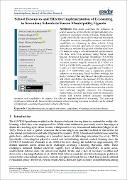| dc.contributor.author | Tobia, Karaha Kyomuhendo | |
| dc.contributor.author | Wilson, Mugizi | |
| dc.contributor.author | Joseph, Rwothumio | |
| dc.contributor.author | Mark, Micheal Waiswa | |
| dc.date.accessioned | 2024-02-01T11:21:36Z | |
| dc.date.available | 2024-02-01T11:21:36Z | |
| dc.date.issued | 2024-01-30 | |
| dc.identifier.citation | Kyomuhendo, T. K., Mugizi, W., Rwothumio, J., & Waiswa, M. M. (2024). School resources and effective implementation of e-Learning in secondary schools in Kasese Municipality, Uganda. Interdisciplinary Journal of Education Research, 6, 1-16. | en_US |
| dc.identifier.uri | DOI: https://doi.org/10.38140/ijer-2024.vol6.01 | |
| dc.identifier.uri | https://hdl.handle.net/20.500.12504/1581 | |
| dc.description.abstract | This study examined the influence of school resources on the effective implementation of e-learning in secondary schools in Kasese Municipality, Uganda. Specifically, the study investigated the impact of tangible resources, intangible resources, and school capabilities on e-learning in these schools. Using quantitative research approach, the study employed a correlational research design and collected data from 170 teachers using a self-administered questionnaire. The data were then analysed using Partial Least Squares Structural Equation Modelling (PLS-SEM). The results of the SEM analysis revealed that school resources, namely tangible resources (? = 0.266, t = 3.612, p = 0.000<0.05), intangible resources (? = 0.234, t = 2.351, p = 0.019<0.05) and capabilities (? = 0.456, t = 5.129, p = 0.000<0.05), had a significant positive influence on e-learning. Based on these findings, the study concluded that tangible and intangible resources and school capabilities are necessary for the effective implementation of e-learning in secondary schools. The study recommends that the Ministry of Education, school directors, and head teachers ensure that schools have sufficient tangible resources for e-learning. Additionally, directors and head teachers should also ensure that schools possess adequate intangible resources and capabilities to support the effective implementation of e-learning. The practical significance of this study lies in its demonstration of how existing resources in schools can be utilised to implement e-learning in secondary schools effectively. | en_US |
| dc.language.iso | en | en_US |
| dc.publisher | Interdisciplinary Journal of Education Research | en_US |
| dc.subject | Tangible resources | en_US |
| dc.subject | Intangible resources | en_US |
| dc.subject | Capabilities | en_US |
| dc.subject | E-learning | en_US |
| dc.subject | Secondary schools. | en_US |
| dc.title | School resources and effective implementation of e-Learning in secondary schools in Kasese Municipality, Uganda | en_US |
| dc.type | Article | en_US |

